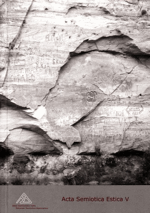Mängud häälte ja piltidega Ernst Enno isikuloo põhjal
Playing with pictures and sounds to open a poet’s biography
Author(s): Katre VäliSubject(s): Semiotics / Semiology
Published by: Eesti Semiootika Selts
Keywords: radio theatre; soundscape; poetry; poet’s biography; oral presentation; raadioteater; luuletaja biograafia; helitaust; luule; suuline esitus
Summary/Abstract: This article compares the interpretations of a play in radio and theatre, paying attention to the emergence of and closeness to the mystic worldview of the playwright and the depicted poet. Radio theatre has several advantages, such as montage, rapid change of sets and locations. This offers possibilities to call into existence various atmospheres. Besides, the signification of poetry is more obvious on radio, where sound and voice are the only meaning carriers, as activities and visual backgrounds do not interfere. While examining radio and theatre I am trying to stress that there is actually a lot of activity, soundscapes and playfulness on radio. Sounsdcapes enable to carry more complex meaning mechanisms and allow listeners to find contact with the limits of their own imagination. All in all visual information is overrated and too easy to follow. The play called “Ennola” is about an Estonian poet Ernst Enno (1875–1934) who was known for his nature lyrics. The poet was interested in German mysticism as well as Eastern philosophy, especially in their views on life and death. Working as a school advisor, he also wrote hundreds of pages on pedagogical problems, all of which remained in manuscripts. His idiosyncratic religious worldview combined folk tales and Bô Yin Râ’s philosophy. The play by an Estonian famous playwright Madis Kõiv is inspired by the poet’s texts, letters and translations. It combines the world of the living and the dead and describes an impossible stage, with bees, fields of shamrock, raining ashes and weird noises. The main idea of this article is that all of these can be best depicted in radio theatre.
Journal: Acta Semiotica Estica
- Issue Year: 2008
- Issue No: 5
- Page Range: 163-180
- Page Count: 18
- Language: Estonian

